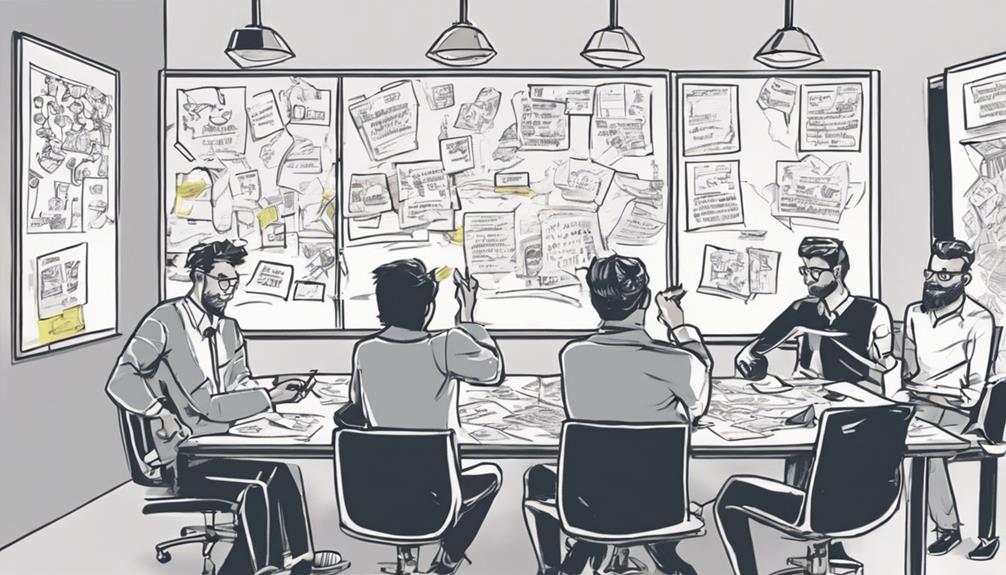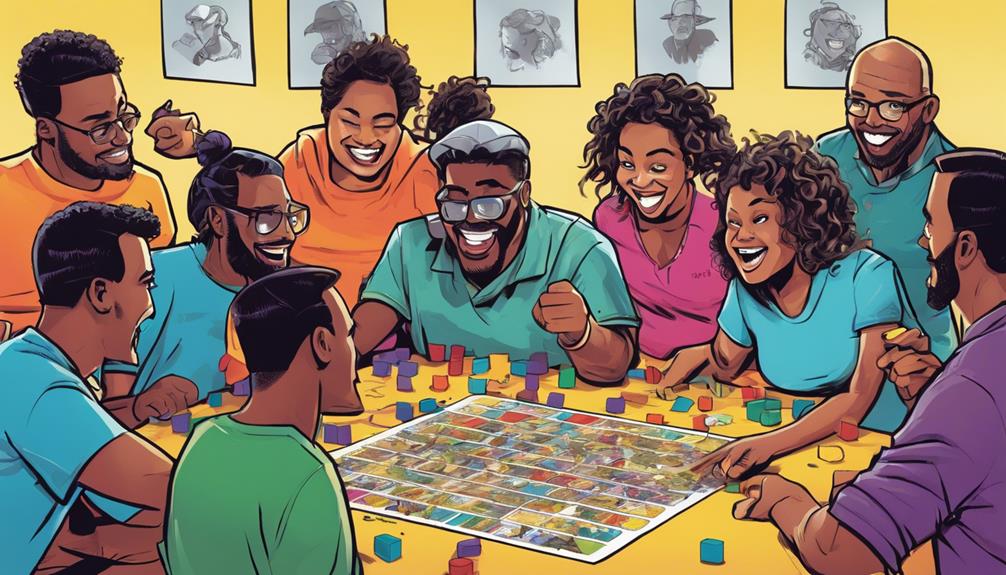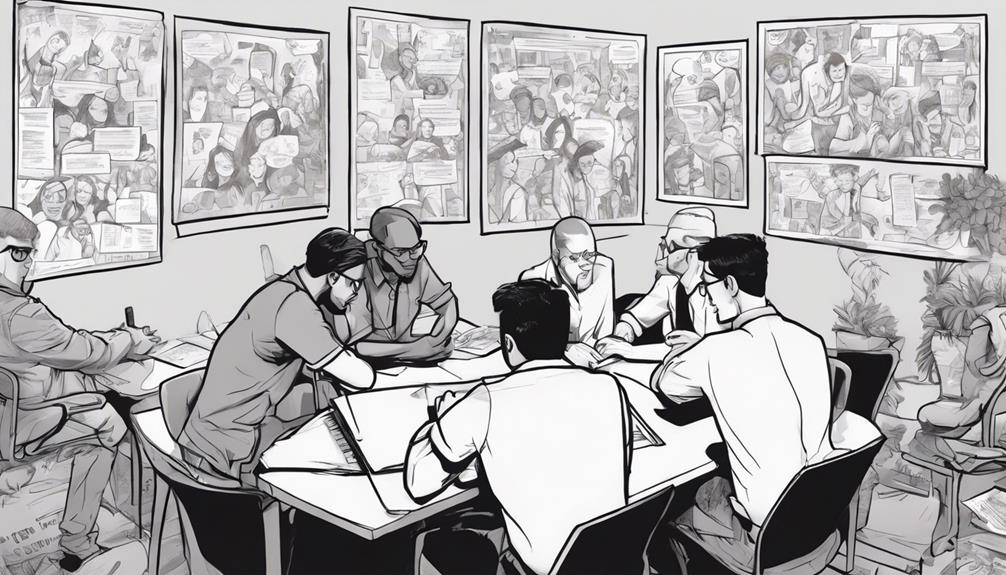One main tool linked to design thinking is Empathy Maps. They help you visualize user perspectives, improve team empathy, and create user-focused, innovative solutions. If you want to discover more about how Empathy Maps can enhance your design process, keep exploring the various components and strategies of design thinking!
Key Takeaways
- Empathy Maps help visualize user needs and behaviors.
- User Personas align product development with user goals.
- Journey Maps illustrate user experiences for improvement.
- Prototyping aids in understanding requirements and gathering feedback.
- Key Components include evaluating solutions, measuring satisfaction, and aligning with business goals.
The Power of Design Thinking
Design thinking leverages the power of empathy and creativity to drive innovation and solve complex problems effectively. By placing users at the core of the design process, design thinking ensures that solutions align with genuine needs and deliver authentic value. This approach involves utilizing tools such as personas, customer journey maps, and prototyping to gain deeper insights into users and refine solutions.
Using personas, design thinkers create intricate profiles that represent various user groups, aiding in understanding users' perspectives, needs, and motivations.
Customer journey maps visualize the user experience from beginning to end, highlighting pain points and opportunities for enhancement.
Prototyping allows for swift iterations and testing of concepts, enabling designers to collect feedback and enhance their solutions based on actual user interactions.
Through these tools, design thinking empowers you to cultivate innovative solutions that resonate with users, ultimately steering meaningful change and developing products and services that genuinely make an impact.
Key Components of an Empathy Map
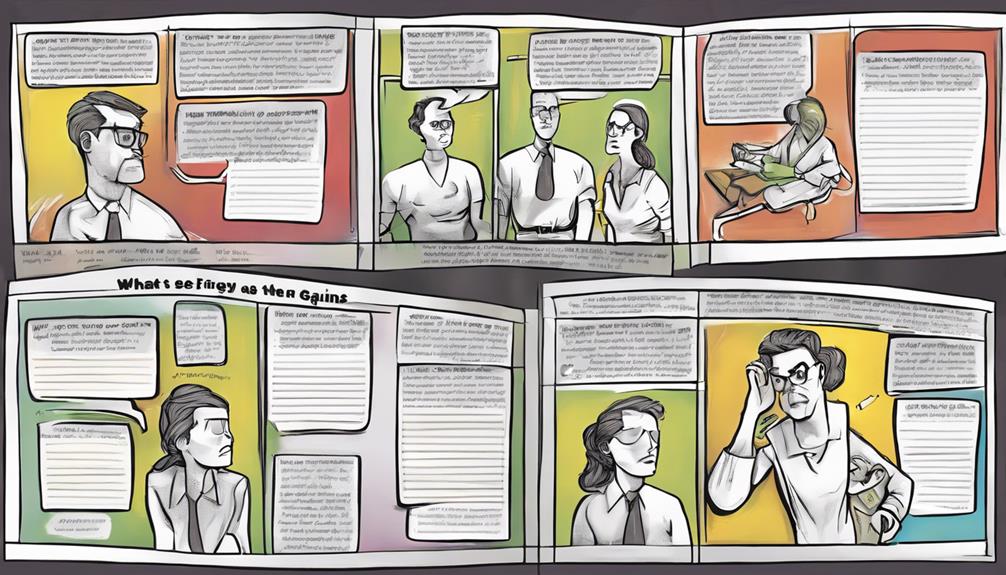
You need to grasp user emotions, visualize their perspectives, and capture their behaviors to create effective solutions. Understanding these key components of an Empathy Map will help you design with the user's needs at the forefront.
Understanding User Emotions
Key elements of an empathy map involve capturing user emotions and motivations through aspects like 'Think and Feel.' When crafting an empathy map as a design thinking tool, it's vital to grasp user emotions to develop emotionally meaningful solutions.
By focusing on user emotions and motivations, teams can gain insights into what propels user behavior. Considering the user's communication style through components like 'Say and Do' and analyzing their physical environment with 'See' helps paint a thorough picture of the user's perspective.
Understanding user emotions is essential for creating products or services that resonate with users on a deeper level. By empathizing with users, teams can tailor their solutions to meet user needs effectively.
Emotions play a significant role in user experiences, and by incorporating them into the design process, teams can develop more impactful and user-centered solutions.
Visualizing User Perspectives
When visualizing user perspectives through an Empathy Map, it's crucial to consider key components like 'Think and Feel,' 'See,' and 'Say and Do.' Empathy Maps are powerful tools that help teams explore user emotions, interactions, and behaviors.
By using these maps, you can gain deep insights into user needs, enabling the development of tailored solutions. Understanding what users think, feel, see, say, and do allows for a more empathetic approach to design.
Empathy Maps foster collaboration among team members, ensuring that everyone is aligned with the users' perspectives. Through the visualization of user thoughts and behaviors, these tools encourage informed design decisions.
Capturing User Behaviors
Capturing user behaviors with an empathy map involves identifying and organizing key components that represent different aspects of user interactions and experiences. This tool, essential in design thinking, explores into users' thoughts, emotions, and needs, providing a structured approach to visualizing their perspectives.
By breaking down user behaviors into categories like 'Think and Feel,' 'See,' 'Say and Do,' and 'Hear,' an empathy map helps in understanding the diverse facets of user experiences. Through this method, team members can develop a shared understanding of users' needs and motivations, fostering empathy within the design process.
The empathetic insight gained from empathy maps is instrumental in guiding design decisions towards creating solutions that resonate emotionally with users. By leveraging empathy maps to capture user behaviors effectively, designers can craft products and services that address user needs in a more meaningful and impactful way.
Using Empathy Maps
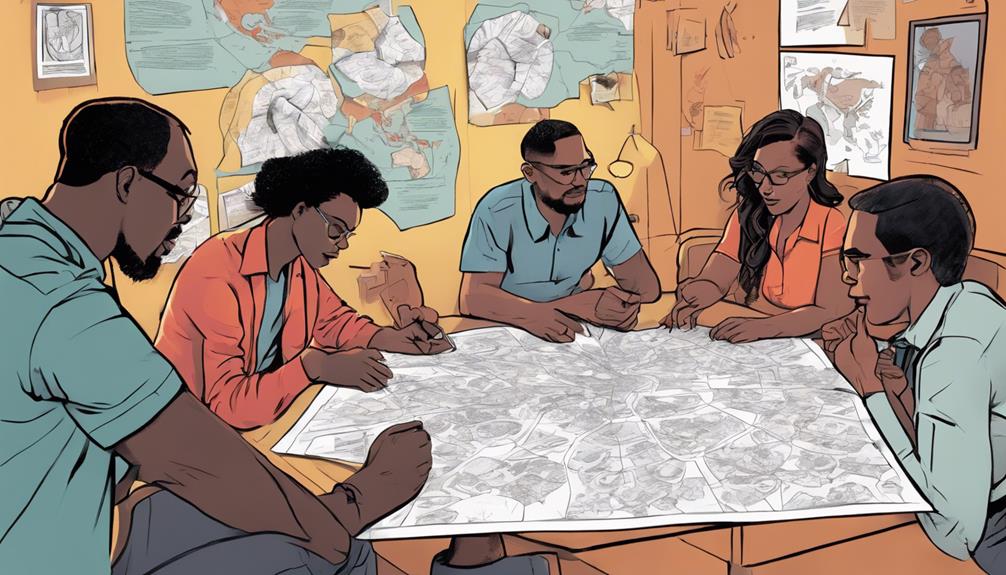
You can leverage Empathy Maps to visually capture user perspectives, enhancing team empathy and fostering a deeper understanding of user insights.
By utilizing these tools, you can create a shared understanding of user needs, thoughts, feelings, and behaviors, leading to more informed design decisions.
Empathy Maps play a pivotal role in guiding design choices and developing solutions based on genuine user experiences.
Visualizing User Perspectives
Empathy Maps serve as a valuable tool for design teams to visualize and understand user perspectives effectively. By focusing on user information such as behaviors, communication styles, and emotional responses, these maps enable teams to create solutions that are emotionally meaningful.
The components of an Empathy Map, including 'Think and Feel', 'See', 'Say and Do', help capture the user's perspective thoroughly. This visualization not only aids in understanding the user but also fosters empathy among team members during the design process.
Through Empathy Maps, teams can gain deep insights into user needs, leading to informed design decisions and effective idea generation. By visualizing user perspectives, teams can empathize with the users' experiences, motivations, and pain points. This understanding allows for the creation of solutions that truly resonate with the users on an emotional level, enhancing the overall design process.
Enhancing Team Empathy
Enhancing team empathy through the utilization of Empathy Maps fosters a deeper understanding of user perspectives and promotes collaborative design decisions. Empathy Maps are an essential tool in the design thinking process, focusing on capturing user needs, thoughts, feelings, and behaviors to aid in creating solutions that resonate emotionally with users. By utilizing Empathy Maps, teams can cultivate empathy and understanding, leading to a shared understanding among team members and enabling more informed design decisions. This tool allows teams to gain deep insights into user perspectives, helping tailor solutions to meet user needs effectively.
| User Needs | Empathy and Understanding | Design Decisions |
|---|---|---|
| Capturing what users require | Fostering empathy among team members | Making informed choices based on user insights |
| Understanding user emotions | Building a shared understanding within the team | Enhancing collaborative design processes |
| Addressing user behaviors | Promoting empathy and understanding | Tailoring solutions to meet user needs effectively |
Understanding User Insights
To gain a thorough understanding of user insights and perspectives in the design process, utilizing Empathy Maps proves essential. These maps are a tool associated with design thinking that focus on capturing user needs, thoughts, feelings, and behaviors in a visual format.
By using Empathy Maps, teams can develop a shared understanding of the users they're designing for, fostering empathy among team members. This shared understanding is vital for creating emotionally meaningful solutions that truly resonate with users.
Empathy Maps help in organizing and visualizing user information, enabling teams to make more informed design decisions based on a deep understanding of user perspectives. Ultimately, by incorporating Empathy Maps into the design process, teams can guarantee that their solutions aren't only innovative but also meet the real needs and desires of the users they serve.
Design Thinking Measure of Success
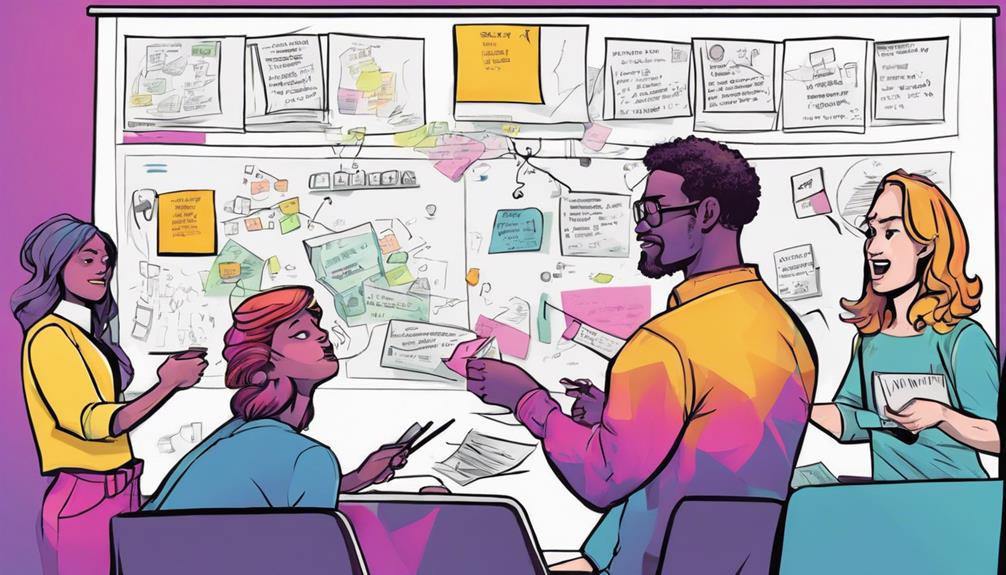
Effective measurement of success in Design Thinking hinges on how well the solutions cater to user needs and pain points, guaranteeing user satisfaction and aligning with business objectives.
To determine the success of a Design Thinking project, consider the following key factors:
- User Needs and Pain Points: Evaluate how thoroughly the solution addresses the identified user needs and pain points to gauge its effectiveness.
- User Satisfaction Levels: Measure the satisfaction levels of users who interact with the implemented solutions to assess the impact on user experience.
- Innovation and Creativity: Assess the level of innovation and creativity embedded in the solution to determine the extent of success achieved through unique approaches.
- Alignment with Business Goals: Guarantee that the solutions align with the overarching business objectives, demonstrating how Design Thinking contributes to strategic outcomes.
Tools for Design Thinking Process
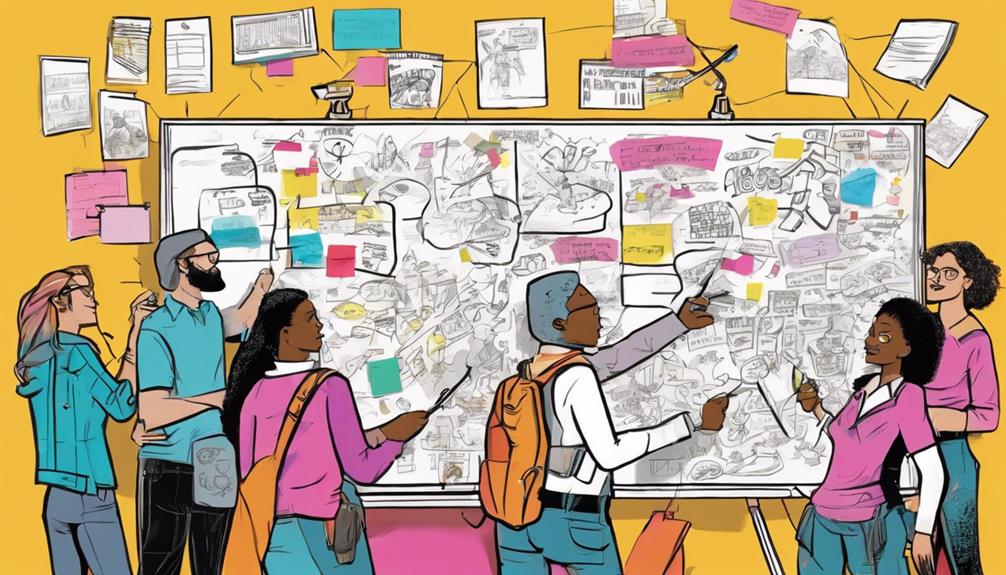
Empathy maps serve as an essential tool in the design thinking process, enabling visualization and understanding of user needs, behaviors, thoughts, and feelings. By using empathy maps, designers can effectively address user requirements throughout the design process. These tools help in creating tailored solutions that meet specific user needs and expectations.
Additionally, empathy maps play a pivotal role in promoting empathy and understanding among team members involved in the design thinking process. Visualizing user behaviors, thoughts, and feelings allows the design team to develop more user-centric and innovative solutions. By focusing on empathy maps, designers can make sure that their designs aren't only visually appealing but also deeply resonate with the target users, leading to products and services that genuinely meet user needs.
Embracing empathy maps in the design process is key to fostering a human-centered approach and creating impactful solutions that address real user challenges.
User-Centric Design Strategies
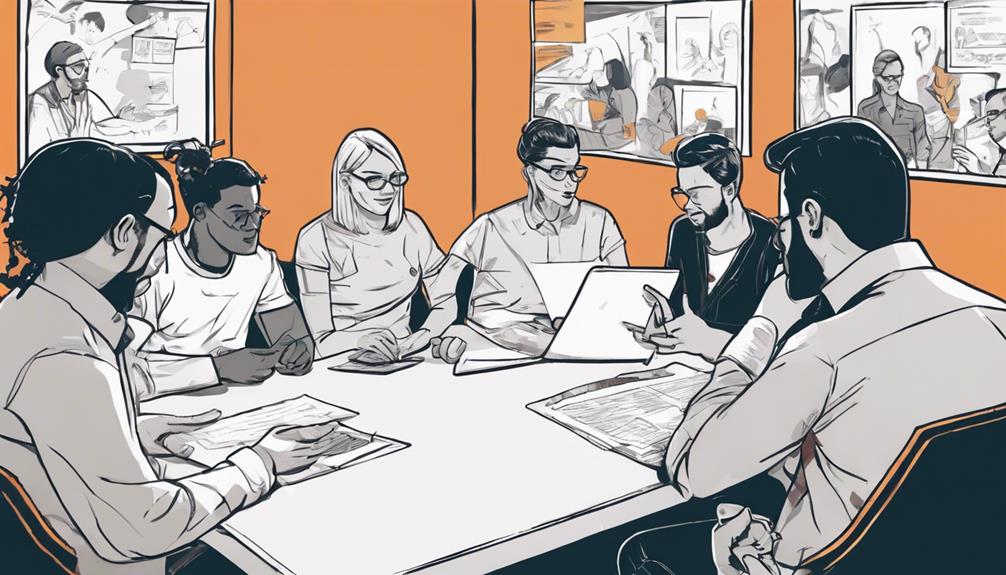
Enhancing user experiences involves implementing user-centric design strategies that prioritize understanding and meeting user needs and preferences effectively. In the domain of design thinking tools, user personas and empathy maps play an essential role in developing products that truly resonate with users.
Here's how these strategies contribute to creating user-centered designs:
- User Personas: By creating user personas, teams can align their product development efforts with the specific behaviors and goals of their target users, ensuring that the end product meets user expectations effectively.
- Empathy Maps: Empathy maps help teams cultivate empathy and understanding by visualizing user information, enabling them to design emotionally resonant solutions that cater to user needs and preferences.
- Journey Maps: Illustrating the user experience through journey maps facilitates a holistic view of the user's interactions with the product, enabling teams to identify opportunities for improvement and enhance overall user engagement.
- Product Development: Both personas and empathy maps drive product development by placing the focus on user-centric design, ensuring that the end product is tailored to meet the needs and expectations of the target audience effectively.
Prototyping and Feedback in Design

Using prototypes in design allows for the clarification of problems and reduction of risks by creating preliminary versions of solutions for testing and feedback. Prototypes provide a fast and cost-effective way to gather feedback from users and stakeholders during the design process. They aid in understanding the requirements of a solution, visualizing concepts, and managing intellectual property related to the design. Lean UX principles emphasize quick iterations, user feedback prioritization, and continuous improvement through prototyping in the design process. By utilizing prototypes in design, teams can iterate on ideas, refine solutions, and ultimately deliver products that meet user needs effectively.
| Key Points | Description |
|---|---|
| Prototypes provide | Fast and cost-effective feedback gathering from users and stakeholders |
| Design process | Aid in understanding requirements, visualizing concepts, and managing IP |
| Lean UX principles | Emphasize quick iterations, user feedback prioritization, and continuous improvement |
| Refine solutions | Utilizing prototypes to iterate on ideas and deliver user-centric products |
Frequently Asked Questions
What Is One of the Tools Associated With Design Thinking in SAFE Agile?
In Safe Agile, one of the tools associated with design thinking is the Portfolio Canvas. It aids in visualizing and aligning portfolio priorities, helping teams understand and communicate strategy effectively while prioritizing based on outcomes.
What Are the Tools Used in Design Thinking?
To excel in design thinking, you embrace tools like empathy maps for understanding, set based design for exploring options, portfolio canvas for organizing, heuristics for quick ideas, and research design for methodical planning.
What Are the Analytical Tools of Design Thinking?
When exploring analytical tools in design thinking, consider Empathy Maps. These tools visualize user needs and emotions, fostering shared understanding and empathy within teams. Gain deep insights into user perspectives to inform design decisions effectively.
What Is One of the Powerful Tool to Ideate During Design Thinking Process?
Open up your creativity and solve problems innovatively with brainstorming, a key tool in design thinking. Generate diverse ideas, embrace wild suggestions, and collaborate freely to explore unique solutions and perspectives.
Conclusion
To sum up, one of the tools linked with design thinking is the Empathy Map. This potent tool aids in comprehending your users' requirements, desires, and sentiments to generate more efficient solutions.
Through the utilization of empathy maps, you can acquire valuable perspectives and develop user-centered designs that genuinely connect with your viewers.
Therefore, don't underestimate the significance of empathy in your design process – it's the essential factor for discovering innovative and influential solutions.
